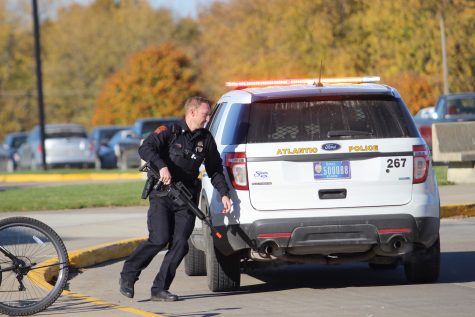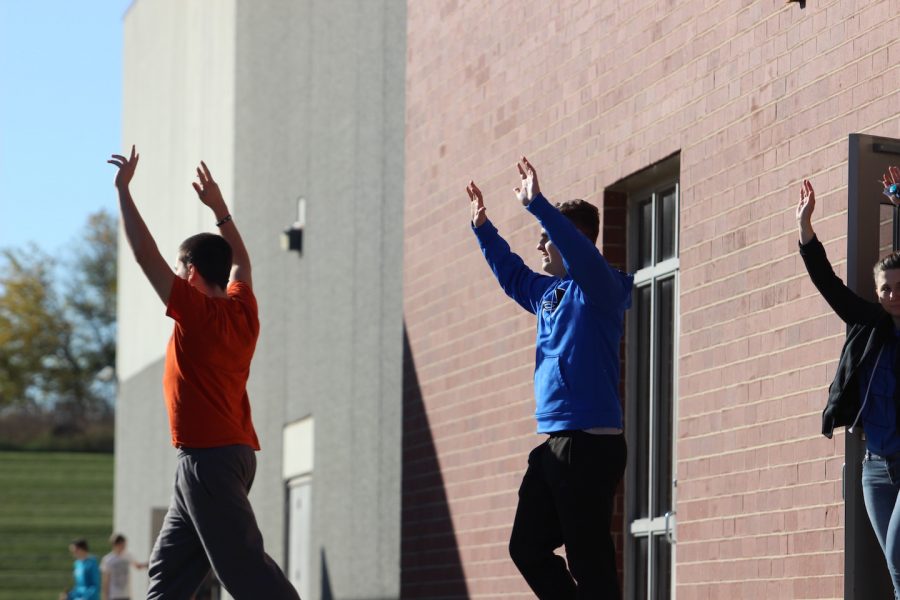First Alice Drill Deemed a Success
Administrators and emergency personnel weigh in on how the drill went down.
Friday, Nov. 4 marked an important date in AHS history: the first ALICE drill of many to come. ALICE stands for Alert, Lockdown, Inform, Counter and Evacuate. Teaming with representatives from seven emergency response agencies, AHS conducted an active shooter drill for the first time in 15 years. Superintendent Dr. Michael Amstein said this was the best relationship he’s seen a school district having with first responders.
The last active shooter plan consisted of a school lockdown, barricade within the classrooms and hiding. The ALICE drill gives more options on what to do. Lieutenant David Erickson of the Atlantic Police Department said, “Our goal is to just get out as many students as we can, and alive.” The part of the plan that goes into action depends on what’s available to students and faculty; it is not step by step. “First and foremost, we just want everyone to be safe,” said principal Heather McKay.
The Atlantic community received calls and/or texts about the drill, as roads were blocked off in the vicinity of the high school. The call/text also prevented community members from thinking that a real shooting had occurred.
Communication with students about this drill began on Oct. 19. The drill wasn’t only practice for students and faculty, it was a learning experience for police officers too, as they’ve never had to respond to a school shooting or mass shooting. “If you look at the society that we live in, this is unfortunately something that we have to train for,” said Officer Devin Hogue.
McKay said, “We really learned what we need to do as an office staff.” She also learned what to say to law enforcement in her call to be more helpful. Two other school district officers came to observe: Griswold and AHSTW. McKay and assistant principal Matt Alexander got ideas from the other officers on how to improve, and vice versa.
The drill did not involve an actual shooter, or even an actor portraying one. Instead, McKay responded as if a man had broken through the front door armed with a long gun, which is when she called 911 and notified them of the armed man.
McKay then proceeded to announce over the intercom the location of the intruder, and to follow the ALICE drill immediately. Students that fled the building either went to the bleachers by the track, or behind the hill on the lower practice field to the west of the school. Officers were dispatched one at a time to show up. As information was received at Instant Command (positioned in the St. Paul’s parking lot) or from emergency personnel outside, it was passed on to the officers inside. At 10:50 a.m., students were let back inside, and emergency personnel left school property.
In case of a real shooting occurring, students wouldn’t be allowed back into the school to get their phones, bags or keys. The school “becomes (the police officer’s) crime scene,” according to Erickson.
Erickson said, “I thought it went rather well. I can’t speak for everybody, but I heard a lot of things that we need to work on, but there was more things that we were really good at.”
An example of something that needs to be worked on is radio communication. It was confusing for different areas, such as Instant Command communicating with those inside versus communication between those running traffic, which made it hard to relay information to the correct person. Erickson commented that different radio stations for each responsibility would help that situation.
Officers conducted a meeting right after the drill about the weak and strong points, and plan to have many more meetings in the future to improve their plan. Officer Spencer Walton said, “For today’s drill, it couldn’t have panned out any better.” Students also had a chance to voice their opinions on what went good and what went bad in their seminar following the drill.
ALICE itself has been a program since 2001. The police have been training with the program since 2012, and communicating with school officials since 2013. Officer Hogue said, “We took the time to do this right.” Teachers, bus drivers, cooks and custodial staff have all been trained.
Officer Hogue said, “It finally got to the point of ‘how do we portray this to the students?’ without Walton and I having to come up here and talk. If we did it large scale in the auditorium, we’re not going to hold attention the way that we want.”
Hogue explained that if the officers had visited with each class individually, his chief’s “head would spin” from all the overtime hours involved.” So they came up with videos. It took a couple of rounds of figuring out how the videos would work. It really came down to a five- minute video that we put together that’s on a secured youtube channel. They can only play it if they have the link, which we sent to the teachers. We challenged a couple kids to make a video last year, so they took ours and made their own,” Hogue said.
Hogue explained that in presenting the program to students, McKay provided a “great introduction” and the officers “followed up with our video, and the students’ video from last year.”
A debriefing with students was held in the auditorium on Monday, Nov. 7 to answer any question about what went on inside during the drill, or questions about what to do in different scenarios in case of the real event. Police officers will now move onto other schools in the district and put together age-appropriate videos explaining ALICE.
Officers plan on taking the drill to the next step, and to continue practicing in the future. “It doesn’t stop here, and it definitely doesn’t end here,” said Officer Hogue.


Emergency Personnel Involved in the ALICE Drill
Two uniformed police officers,
Two deputies
Two off-duty officers
A state trooper
Medivac Ambulance
Atlantic Fire Department
Instant Command communication center

Chloé Newbury is the social media manager and chief on the AHS Journalism team. When asked what project she was most proud of during her career she said...

